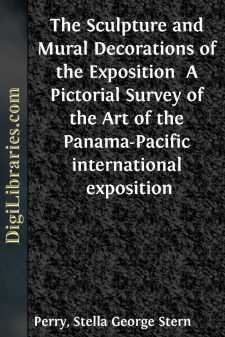Categories
- Antiques & Collectibles 13
- Architecture 36
- Art 48
- Bibles 22
- Biography & Autobiography 813
- Body, Mind & Spirit 142
- Business & Economics 28
- Children's Books 15
- Children's Fiction 12
- Computers 4
- Cooking 94
- Crafts & Hobbies 4
- Drama 346
- Education 46
- Family & Relationships 57
- Fiction 11828
- Games 19
- Gardening 17
- Health & Fitness 34
- History 1377
- House & Home 1
- Humor 147
- Juvenile Fiction 1873
- Juvenile Nonfiction 202
- Language Arts & Disciplines 88
- Law 16
- Literary Collections 686
- Literary Criticism 179
- Mathematics 13
- Medical 41
- Music 40
- Nature 179
- Non-Classifiable 1768
- Performing Arts 7
- Periodicals 1453
- Philosophy 64
- Photography 2
- Poetry 896
- Political Science 203
- Psychology 42
- Reference 154
- Religion 513
- Science 126
- Self-Help 84
- Social Science 81
- Sports & Recreation 34
- Study Aids 3
- Technology & Engineering 59
- Transportation 23
- Travel 463
- True Crime 29
The Sculpture and Mural Decorations of the Exposition A Pictorial Survey of the Art of the Panama-Pacific international exposition
Categories:
Description:
Excerpt
The Sculpture and Mural Decorations
"In this fair world of dreams and vagary,
Where all is weak and clothed in failing forms,
Where skies and trees and beauties speak of change,
And always wear a garb that's like our minds,
We hear a cry from those who are about
And from within we hear a quiet voice
That drives us on to do, and do, and do."
The persistent necessity for creation is strikingly proved by the prolific output of the Arts. Year after year, as we whirl through space on our mysterious destiny, undeterred by apparent futility, the primal instinct for the visualization of dreams steadily persists. Good or bad, useful or useless, it must be satisfied. It amounts to a law, like the attraction of the sexes. Discouraged in some directions, it will out in others, never permanently satisfied. Each age and people must have its own art as well as what remains of the arts of past ages and peoples - in spite of scant patronage, commercial limitation, and critics' hostility. The philosopher tells us that everything has been done, yet we must do it again - personally.
Art is so much a part of life that to discourage it is to discourage life itself - as if one would say: "Others have lived; all imaginable kinds of life have been lived. Therefore it is unnecessary for you to experience life."
The plastic and pictorial decoration of an Exposition offer unusual opportunity to the Artist, at the same time imposing handicaps - the briefness of time, the poverty of material. It affords chances for experiment, invention, and originality only limited by the necessary formal settings of the architecture, out of proportion to the initiative of the artists, a majority of whom prefer, either from inclination or necessity, to take the safe course, the beaten path of precedent. Artists are of two kinds - the Imitators and the Innovators. The public also is of two corresponding kinds - those who accept only what they have learned to regard as good, preferring imitations of it to anything requiring the acquisition of a new viewpoint; and that other kind, receptive to new sensations. The first class is the more numerous, which explains why most of our art, in fact most of all art, is imitative - that is, imitative of the works of other artists.
The sculpture and mural decorations of the buildings and grounds of the Exposition adequately represent the output of American art today. It is the best possible collection under existent conditions.
Its many sources of inspiration - all European, like the sources of our racial origin - are clothed in outward resemblances of the styles and tinged with the thought of the masters, old and new, who constitute Precedent. Thus, in sculpture we have imitations, conscious or unconscious, of the Greek, of Michael Angelo, Donatello, Rodin, Barye, Meunier, Saint Gaudens; in painting, of Besnard, Merson, Monet, et cetera, as well as some more complex personal notes, more difficult to relate, although they too are related in the main, adding only another variation of character to the great mass of human ideality....


